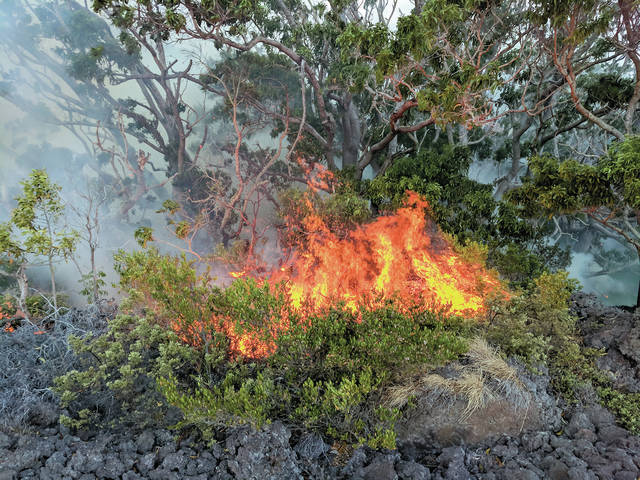Volcano gave ‘hints’ activity would decrease


NATIONAL PARK SERVICE photo Smoke rises from a brush fire Sunday on Mauna Loa. Strong winds and dry conditions at the fire’s 4,800-foot elevation are making it a challenge to control.

U.S. Geological Survey photos At left is Halema‘uma‘u crater at Kilauea volcano’s summit and the active lava lake within the crater are visible on April 13, 2018. At right is a comparable view on July 28 following recent collapses of the crater.

U.S. Geological Survey photo
This aerial photo of Isaac Hale Beach Park and Pohoiki boat ramp was taken during Sunday morning’s overflight. The lava ocean entry and a small laze plume can be seen curling around the park and its parking lot.
The scientist-in-charge at Hawaiian Volcano Observatory said there “were some hints” the near cessation of seismic activity at Kilauea’s summit and drastic reduction of lava production by fissure 8 might happen.
The scientist-in-charge at Hawaiian Volcano Observatory said there “were some hints” the near cessation of seismic activity at Kilauea’s summit and drastic reduction of lava production by fissure 8 might happen.
Tina Neal said during a media briefing Monday that “in retrospect” the laze plume and dramatic increase in sulfur dioxide (SO2) gas emission at Pu‘u ‘O‘o vent noted Friday by scientists was a “potential hint that the system was changing.”
ADVERTISING
Neal said that after the summit collapse event on April 30, Pu‘u ‘O‘o “really went quiet.”
“And we saw nothing and no activity and no plume there, once the rockfall dust from that collapse settled,” Neal said.
She said the output of SO2 from the vent went from between 100 to 150 tons per day to more than 1,000 tons per day, “the highest output from Pu‘u ‘O‘o … in more than 10 years.”
“That’s very interesting. We do not fully understand what that means,” she said. “… It does mean that there’s magma at a very shallow level below Pu‘u ‘O‘o that’s degassing. Whether that means that system is moving toward lava re-emerging in Pu‘u ‘O‘o or not, we just can’t say. That will be a surprise to us if that happens.”
Neal said it’s too soon to call an end to the current eruptive phase in the volcano’s lower East Rift Zone, which began May 3 and destroyed more than 700 homes in lower Puna. She said scientists will “stay vigilant” and continue to monitor the volcano.
She added HVO will not send field crews to the lower East Rift Zone on Wednesday on the advice of Civil Defense, as Hurricane Hector is expected to pass south of the island sometime that morning and could bring tropical storm force winds to parts of the Big Island.
County officials also canceled a community meeting about the eruption scheduled for this evening in Pahoa because emergency personnel are preparing for Hector’s arrival.
Seismic activity at the summit has wreaked havoc on infrastructure and caused unsafe conditions in Hawaii Volcanoes National Park, causing closure of most of the park on May 11. Park spokeswoman Jessica Ferracane said she had “quite a few questions come in … about when will the park reopen” since the reduction in volcanic activity.
“It is really too early to tell what Kilauea will do next, and the hazard has certainly not decreased at the moment, and we don’t know what’s happening next, so I don’t know,” Ferracane said.
Large sinkholes and fractured asphalt on Highway 11 are being repaired by state highway workers, necessitating one-lane closures and a reduced 25 mph speed limit. Government agencies are working together to create alternate and emergency routes should the highway fail.
But the fate of park features such as Thurston Lava Tube are unknown because it’s too risky to send anyone inside to take a look.
“We miss being in the park, we miss sharing Hawaii Volcanoes National Park with visitors from around the world and across the street. We realize the extended closure is very hard on our community and disappointing to travelers. It’s hard on all of us, and we appreciate everyone’s continued understanding and support,” said HVNP Superintendent Cindy Orlando.
In addition, a brush fire that started Sunday morning on Keauhou Ranch crossed Mauna Loa Road into the national park, and was moving west as of press time. National Park Service and county firefighters were working to control the blaze, which was estimated at about 700 acres Monday.
The fire is moving west toward Kapapala Ranch, and wasn’t contained as of press time. Outside the park, county and state firefighters were working with volunteer firefighters from Volcano to suppress the fire, which was reportedly sparked during repairs to a bulldozer, outside the park.
Strong winds and dry conditions at the fire’s 4,800-foot elevation were making it a challenge to control. No homes or structures were in jeopardy, but the fire has scorched native koa forest, which provides important habitat to endangered and endemic species such as the Hawaiian hawk and Hawaiian hoary bat.
Email John Burnett at jburnett@hawaiitribune-herald.com.


